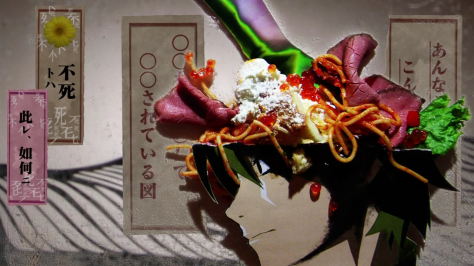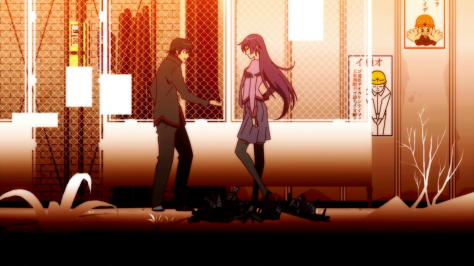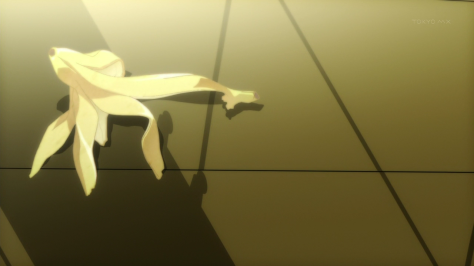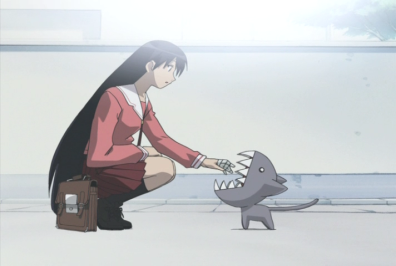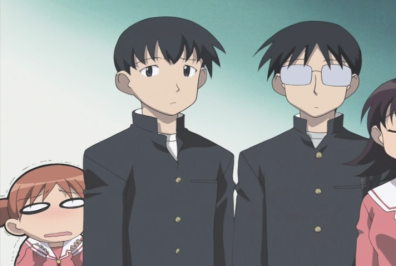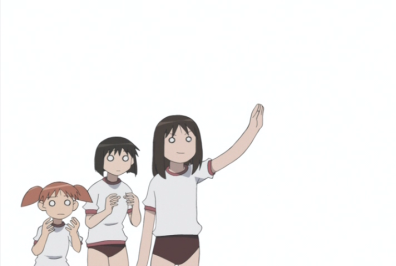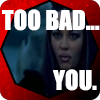Japanese Title: Bakemonogatari
Related: Nisemonogatari (sequel)
Similar: Katanagatari
Watched in: Japanese
Genre: Contemporary Fantasy Romance
Length: 13 episodes (12 is the finale; 13 is a bonus)
Positives:
- Fantastic art style and animation to create a vibrant, yet haunting world.
- Well-suited music to the dialogue heavy plot.
- Strong male and female protagonists.
- Solid voice work to accompany the varied dialogue.
- Dark humour from lead female is a pleasant change of pace.
Negatives:
- Incoherent story overall marred by throwaway side characters.
- Random screens of text flashing every few seconds.
- Sexually creepy at times.
- Too little character development, even from the protagonists.
- No world building despite the incredible visual design.
Bakemonogatari is one weird anime. You don’t get many as weird as this one. This anime has people with spaghetti for brains and staplers as weapons. Probably the most normal thing here, as far as anime goes, is starting with a pantie-shot. From then on, it goes to a whole different dimension. The question we ask ourselves: Is this weirdness good? It does create greatness, but unfortunately, it brings several poor decisions along for the ride.
Immediately, I was struck by the vivid art of Bakemonogatari. Its brilliant use of light, shade, and colour is gorgeous. There is style here, plenty of it. Gradients give backgrounds depth on top of the multi-layering. All colour choice is deliberate, intended to match the mood and atmosphere of the characters and their situations, even at the cost of continuity – a room could be bright one moment and change to dark if the situation called for it, regardless of realism.
It is a shame then that poor choices mar these visuals. Bakemonogatari use a mix of live-action, stop-motion, collage pages, and text for metaphors and similes. At times, the change in art is both hilarious and clever, the rest, tedious and forced. The worst offenders are the screens of text; they flash at random intervals for no purpose. Every instance broke my immersion. Get used to seeing a flat colour with Japanese lettering and the subtitle ‘unidentified cut’ underneath. A dozen times. Per episode. Every episode. Unbelievably stupid decision to kill the atmosphere. It feels as though they had a great idea to use live-action, collages, and so on, and found them to work so well that they thought, ‘why not add more?!’ only to kill it all by going too far. Such a shame.
The plot swims in much the same ocean as the alternative art styles: greatness weighed by poor decisions. We start with protagonist, Araragi, running up a grand spiral staircase in what you can assume is his high-school (most expensive high-school I have ever seen, especially considering no one goes there – more later). He looks up to see a girl falling down the hundred-meter tower. He catches her (don’t question how she drifts twenty meters from the central axis into the stairs) only to find she weighs five kilos (still enough that it should have broken his arms from that height, however). With Senjougahara’s secret revealed, she cannot let him go; she attacks armed with a box cutter and a stapler. After she staples the inside of his cheek for the fun of it, he pulls open his mouth to show no wound. Turns out Araragi recently reverted to human after a stint as a vampire. They become tenuous allies to return Senjougahara’s stolen weight (from a giant ghost crab that also took her memories) with the help of his acquaintance who cured his vampirism.
This initial premise captured my interest; unfortunate then that it lasted but a few episodes before it took a tangent about a little girl with another supernatural problem. The tangent itself wasn’t poor, but lacked development of the main plot and romance. When yet another girl with a paranormal issue enters afterwards, one realises this show is on a formulaic cycle and has little to do with the initial promise. His former life as a vampire has no bearing on the plot. Senjougahara’s backstory seems forgotten, and the relationship development stalls until episode twelve – a fantastic episode, admittedly.
In all, five girls partake, including the lead female, which is why you see Bakemonogatari categorised as a harem anime, yet this isn’t one. Yes, creepy sexualisation exists with a side character or two, but nothing that constitutes a relationship or even a crush required by harem anime. At least they made the correct decision in that aspect.
One of the strangest factors is how the entire world’s population is nine: protagonist, five girls, mystic, minor vampire girl, and Senjougahara’s father. That’s it. No background characters at all, not even in a school big enough to have a glass tower of no purpose, and parking for a thousand bicycles. Is this a problem though? Not really, but it did reduce world depth. This brings me to another negative: no world building. Why is this ghost crab after her? Where do all these supernatural elements come from? Where is the lore, the backstory? You get nothing. The world feels empty despite the visual depth.
Bakemonogatari is heavily dialogue driven. You have to pay attention, as it moves at a brisk pace while you extrapolate what is relevant from the random junk littered throughout. Episodes tend to diverge halfway through into some long-winded tangent before they return on track – medium success rate. The camera likes to cut away to different angles during dialogue. Focus on someone’s feet, then their hands, the corner of the table, the wall, a badly framed shot of the face. Prepare for irrelevance as well. The side of a building, some grass, a window, dirt, more grass…
Allow me to stress that this isn’t for children, and not because of the nudity. Topics of discussion range from Araragi’s virginity to Senjougahara’s choice of clothing and even to some specific types of incest-like fetishes. Honestly, I didn’t even know those were actual fetishes… Anyway, they deal with deep psychological issues caused by broken families and assault on loved ones. Dialogues are largely between the two lead characters, where Bakemonogatari is at its best. The dynamic between these two is a pleasure to watch. I find it hilarious how her attempts to help him with problems (she’s the more mature of the two), end up abusing him instead, making things worse, except, she honestly believes she’s helping. The humour is along those lines: serious in delivery, ironic in reception. His stray lock of hair being a symbol for his arousal level is clever too.
Despite the negatives, Bakemonogatari is still an anime worth watching. For maximum enjoyment, I recommend you watch no more than three episodes at a time to avoid overload and to maintain your focus throughout. Marvel at the art, focus on the lead characters, and you will end with a positive opinion.
Art – Very High
Truly spectacular. From the light to the shade, marvellous work here. However, it is brought down by some obnoxious screen flashes that occur far too often.
Sound – High
The right actors to match the great dialogue. Music is enjoyable too, outside of the opening and closing sequences.
Story – High
Moments of greatness distracted by random elements thrown in for the sake of being random. Three of the five story arcs fall flat.
Overall Quality – High
Recommendation: Watch this for what it does right. Take Bakemonogatari in small doses to stave off what it does wrong.
(Request reviews here. Find out more about the rating system here.)
Awards: (hover mouse over each award to see descriptions; click award for more recipients)
Positive:
Negative:


